A.N.A. - Associate member of the American honorary association of artists, the National Academy, or National Academy of Design. N.A. indicates a full member.
anaglyph - A sculpture or decoration in relief, such as a cameo.
analog or analogue - Something that bears an analogy to something else. A photograph records the image of something, while an analog computer (also analogue computer) represents numerical data with measurable physical variables, such as electrical signals. Standard audiotape and videotape recordings are produced by an analog process, as a continuous wave, rather than digitally in a binary form. Digital recording is now crowding out analog recording technology, just as digital computing has triumphed over analog computing. To those immersed in the virtual worlds of computer activities (to "geeks" including you dear reader?!), analog may broadly refer to things in the "real world" — to that which cannot be accessed via a keyboard, indeed to anything messy! (Geek-speak is variously scary and amusing. Its terms for humans, for instance, include wetware and meatbots.) Analog is a variant of analogue.
(pr. AN-ə-LAWG)
Also see analog-to-digital conversion, chaos, order, and sequence.
analogous colors - Any two or more colors that are next to each other on the color wheel and are closely related. For example, blue, blue-green, and green all have the color blue in common. Families of analogous colors include the warm colors (red, orange and yellow) and the cool colors (green, blue and violet). Analogous colors are sometimes referred to as adjacent colors.
(pr. a-NA-lə-GUS)
Also see achromatic, color scheme, complementary colors, grisaille, monochromatic, split complementary, and triadic colors.
analog-to-digital conversion - The electronic process of changing continuously varying wave-form data into digital quantities that represent the magnitude of the data at the moment the conversion is made. The most common use is to change analog signals into a form that can be manipulated by digital computer, as in data communications. You employ this process when you use your computer's microphone to record sounds, for instance. You'll use this process if you converted television/video signals into images your computer can manipulate.
Also see moiré.
analogue - See analog.
analogy - A comparison between things based upon observations of a significant similarity between them, while acknowledging that they are otherwise dissimilar. Makers of analogies generally infer that if these things are so similar then they are probably alike in other ways. Analogies are usually made to illustrate or explain complex or unfamiliar ideas. Any things similar or alike in such a way as to permit the drawing of an analogy may be called analogous. Analogy is a basic component of symbolism.
(pr. a-NAL-ə-JEE)
About analogies:
Also see appropriation, copy, copyright, counterfeit, ersatz, facsimile, fake, forgery, incongruity, interdisciplinary, likeness, metaphor, mirror, positive, proportion, replica, representation, reproduction, scale, simile, simulacrum, and simulation.
analysis - The separation of the parts of a subject for individual study, in order to find out their nature, function, and meaning. Exercising the ability to break down learned material into its component parts so that its organizational structure may be understood.
Analysis is a stage in art criticism, following the description of an artwork, and preceding its interpretation and judgment, in which one focuses on the relationships between the elements of art and principles of design in hopes of gaining an understanding of the work's design qualities, or how well the work is ordered, or put together. This understanding enables one to determine if a work has an overall sense of unity.
Analysis represents the fourth level of learning outcomes in the cognitive domain — the level of understanding just beyond comprehension and application because they require an understanding of both the content and the structural form of the material. Analysis may include the identification of the parts, analysis of the relationships between parts, and recognition of the organizational principles involved. Objectives of lessons which will increase a student's ability to analyze knowledge can be stated with such behavioral terms as: analyze, appraise, audit, break down, characterize, check, classify, compare, conclude (draw conclusions) contrast, debate, deduce, determine, diagram, differentiate, discriminate, dissect, distinguish, examine, experiment, generalize, graph, illustrate, inspect, infer, inventory, map, point out, outline (no format given), question, reason, refute, relate to, research, screen, scrutinize, search, section, select, separate, sift, simplify, solve, study, subdivide, survey, syllogize, test, and uncover. The next higher thinking skill is synthesis.
Quote:
Also see bias, Bloom's Taxonomy, definition, and infrared reflectography (IR) and reflectogram.
analytic - Having to do with analysis — dividing into elemental parts or basic principles. Reasoning or acting from a perception of the parts and their interrelationships. In philosophy, the opposite of synthetic.
(pr. AN-ə-LI-tək)
anamorphosis and anamorphic art -  An image
that appears distorted, because
it is constructed on an elongated
grid, rendering it unintelligible
until it is viewed from a specific, extremely oblique
point of view or reflected
in a curved mirror, or with some other
optical device. "Anamorphosis"
is a Greek word meaning transformation,
or more literally "formed again." Road signs
such as "SCHOOL CROSSWALK" and directional arrows are
designed anamorphically — stretched out — when painted on pavement,
so that these signs are easily understood by the drivers who must
view them obliquely. Do not confuse anamorphosis with metamorphosis.
An image
that appears distorted, because
it is constructed on an elongated
grid, rendering it unintelligible
until it is viewed from a specific, extremely oblique
point of view or reflected
in a curved mirror, or with some other
optical device. "Anamorphosis"
is a Greek word meaning transformation,
or more literally "formed again." Road signs
such as "SCHOOL CROSSWALK" and directional arrows are
designed anamorphically — stretched out — when painted on pavement,
so that these signs are easily understood by the drivers who must
view them obliquely. Do not confuse anamorphosis with metamorphosis.
Examples:
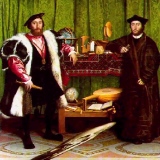

Hans Holbein (German, 1497/8-1543), The Ambassadors,
oil. A human skull in the
lower third of the painting can be seen
undistorted only from a viewpoint that is
near and below the painting, and to its left. See vanitas.
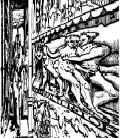

Erhard Schön (German, 1691-1742), Distortion,
1538. Immediately one sees on the left four people in a room,
and an odd landscape to the right.
Viewing this picture obliquely from its right
reveals the anamorphic image of an embracing couple.

Follower of Caravaggio, anamorphic Saint
Jerome Praying, 1635, oil
on canvas. See Caravaggisti.
Netherlands, 1700s, Verwagt nog beeter (Expect Even Better) and Abstraction turning into a carnation, copper alloy cone and anamorphic watercolors, two in a set of several images, each: 10 5/8 x 10 5/8 inches; reflecting cone: 3 1/8 x 3 1/8 inches; Getty Research Institute, Werner Nekes Collection. Anamorphic images which depend upon the use of a curved mirror — usually conical or cylindrical — are called "catoptric" or "katoptric." These are two of 22 objects in the Devices of Wonder exhibit catalogued online by the Getty Museum — best seen with Flash and RealAudio plugins.
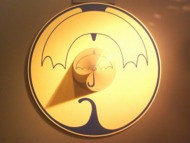
An
Umbrella, 20th century. A mysterious image is drawn on
a circular ground. It is actually a distorted depiction of an
umbrella. It can be seen undistorted only be placing a
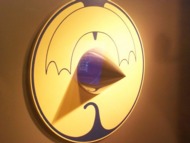 conical mirror upon
its center, and looking at it from one particular position. The
undistorted umbrella can be seen in the center of this photograph.
conical mirror upon
its center, and looking at it from one particular position. The
undistorted umbrella can be seen in the center of this photograph.
The
same two objects, as seen from off to one side. Here the
reflection in the cone makes no sense as an umbrella, because
our point of view is not at the correct angle.

Snowflakes,
20th century, seen with a cylindrical mirror.
In photography, an anamorphic lens is capable of compressing a wide angle of view onto a standard frame of film. A similar projection system can be used to reform such an image onto a wide screen. Holywood movie company Metro-Goldwyn-Mayer devised an anamorphic lens system in 1957 for 35mm film with a compression ratio of 1.25:1, that is sometimes called "M-G-M Camera 65" and sometimes "Ultra Panavision." The system employed a pair of achromatized Brewster prisms in order to expand a projected image anamorphically, and was first used for the films Raintree County and Ben-Hur.
Related links:
Also see aspect ratio, closure, fish-eye lens, foreshortening, grid, reversible, and trompe l'oeil.
anastole - The Greek name for a hairstyle in which the hair is brushed up from the forehead, arranged wreath-like around the face, and typical in portraits of Alexander the Great (356-323).
Examples:
![]()

Greek, about 320 BCE,
Head of Alexander the Great, marble, height
11 inches, J. Paul Getty Museum, Malibu, CA.

Greek, Bust of Alexander, Glyptothek,
München. See bust.
![]()

![]()
Greek, Bust of Alexander, stone,
found at Thasos.
Also see Hellenistic.
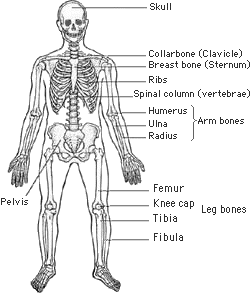 anatomy - The study of body structure,
whether human or animal, including the bones,
the muscles, and all the other parts. Knowledge of anatomy is
important to drawing and sculpting
human and animal figures
well.
anatomy - The study of body structure,
whether human or animal, including the bones,
the muscles, and all the other parts. Knowledge of anatomy is
important to drawing and sculpting
human and animal figures
well.
Examples of anatomical images:
Andreas Vesalius (Dutch, 1514-1564) and
Johannes Stephan van Calcar, a pupil of Titian, Standing  Skeletons, A Body Disected and Suspended,
Skeletons, A Body Disected and Suspended, The Bones of the Human Hand, 1555, woodcuts from De Fabrica.
See the frontispiece to this book.

Jean-Antoine Houdon (French, 1741-1828),
L'Écorché
(Flayed Man, Standing), 1767,
plaster cast taken from the original
écorché (in
marble?) Such
life-size sculptures of a flayed man have served
as models for art students
studying human anatomy, in preparation for life
drawing. Students' uses of such figures has diminished greatly since the end
of the nineteenth century.
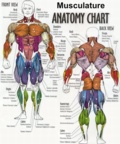
American, Anatomy Chart of Musculature, late 20th
century illustration. This diagram
was apparently designed for body-builders. Individual muscles
in all of the major muscle groups are color coded and named.
Human skeletal system, contemporary illustration.
Also see ala and alar groove, bone structure, bust, ergonomics, human scale, iris, lens, philtrum, pupil, retina, rods and cones, nude, philtrum, portrait, seeing, sight, ophthalmology, science and art, self-portrait, and septum.
anchoring gaze - The principal direction of gaze — or line of sight — of people who are in conversation.
Also see conversation piece and point of view.
ancien régime - French for the old order; the feudal, absolute monarchy in France before the French Revolution in 1789.
(pr. AHN-see-ən ray-JEEM)
Also see Baroque, Gothic, Middle Ages, Neoclassicism, Renaissance, and Rococo.
ancient - Loosely, very old, antiquated or old-fashioned. Often more specifically of the ages before the fall of the Western Roman Empire in 476 CE; especially of China, Egypt, Greece, Rome, etc.
Also see Buddhist art, Egyptian art, encaustic, Etruscan art, Greek art, Hindu art, Islamic art, Roman art, and Stone Age art.
ancipital - Two-edged.
May also mean two-headed. Among the symbols of several European nations are ancipital eagles.
(pr. an-SI-pə-təl)
Examples in this second sense:

Austrian, Hyacinth "La Bella", mounting:
Vienna (?) c. 1687, garnet (almandine), gold, silver-gilt, enamel, gem:
height 6.8 cm, width
3.9 cm, weight 416 carats,
mounting: height 19.9 cm, width 15.8 cm, Kunsthistoriches
Museum, Vienna.

![]()
This Albanian postage stamp bears an ancipital
eagle, as does
the flag of Albania. See philately
and flags of Europe.
![]()

The coat of arms of Montenegro. See coat
of arms.
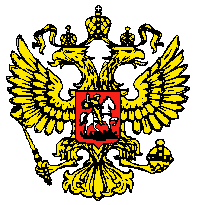
The coat of arms of Russia. See coat
of arms.

Also see addorsed, bookplate, emblem, heraldry, Janus, and seal.
Andachtsbild - German for devotional picture; votive art. A picture or sculpture with a type of imagery intended for private devotion, first developed in Northern Europe.
androcentrism - A specifically male anthropocentrism. A typical, though simple example is the use of the pronoun "he" to refer to both genders.
Also see Afrocentrism, ethnocentrism, Eurocentrism, feminism, gender issues, and isms and -ism.
androgyny and androgynous - Having both male and female characteristics or qualities. The use of androgynous figures in mythology is widespread. In Greek mythology, for example, the minor god Hermaphroditus became both male and female after the nymph Salacis was united with him in one body. The concept of androgyny has been further developed by those following the psychological theory that human personality is invariably made up of both male and female characteristics. The feminist movement has promoted the notion that if males develop their feminine side and women their masculine side, differences could be lessened, and rigid stereotyping avoided.
Examples of art exploring androgyny:
Roman copy after a Hellenistic original from the 2nd century BCE, Sleeping Hermaphrodite, marble, length 169 cm, Louvre. Ovid told the story of Hermaphroditus in his Metamorphoses (IV, 285...): Hermaphroditus was the son of Mercury and Venus. When the boy was 15, he and the nymph Salmacis were so in love with one another, that they prayed they would never part. The gods then made them one, with a body both male and female.
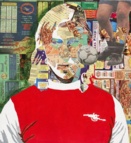
Sarah Lucas (British, 1962-), Geezer, 2002, oil, cut-and-pasted printed paper, and pencil on wood, 31 7/8 x 29 1/2 inches (81 x 74.9 cm), Museum of Modern Art, NY.
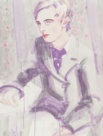
Elizabeth Peyton (American, born 1965), Bosie, 1998, lithograph, 29 5/8 x 22 1/2 inches (75.2 x 57.2 cm), publisher: the artist, Gavin Brown and Derrière L'Étoile Studios, NY; printer: Derrière L'Étoile Studios, NY; edition: 45; Museum of Modern Art, NY.
Also see gender issues.
angle - An angle is a figure formed by two lines or edges diverging from or crossing a common point (vertex) — an acute angle being less than 90°, a right angle being 90°, and an obtuse angle being greater than 90° but less than 180° — measured with a protractor. Or, the figure formed by two planes diverging from a common line. "Angle" can refer to the space between such lines or surfaces, and it can also refer to a direction or point of view. Among the kinds of lenses, a wide-angle lens is the opposite of a telephoto lens.
Also see aculeate, angle of incidence, align, bevel, bias, chamfer, Daguerreotype, fold, miter, negative, perpendicular, point, positive, straight, tangent, and undercut.
angle of incidence - When light (incident light — that from a source of light) strikes an object's surface it forms an angle with an imaginary line known as the "normal," which is perpendicular to the surface. The angle created between the incident ray and the normal ray is referred to as the angle of incidence.
Also see absorption, mirror, optical mixing, plane, primary colors, reflected light, wavelength.
Anglo-Saxon art - An art style of the fifth to eleventh centuries in England. It is characterized by interlaced motif.
Also see Celtic art and Middle Ages.
angst - In German, an emotional state of anxiety without a specific cause. In existentialism, the term refers to general human anxiety at having free will, that is, of being responsible for one's actions.
Examples of works in which angst is important:
![]()
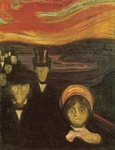
![]()
Edvard Munch (Norwegian, 1863-1944), Anxiety, 1894, oil on canvas, 94 x 73 cm.
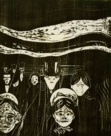
Edvard Munch, Angst, 1896, woodcut, composition: 18 1/16 x 14 7/8 inches (45.9 x 37.8 cm); sheet: 19 5/16 x 15 3/4 inches (49 x 40 cm); publisher: the artist, Paris; printer: Auguste Clot, Paris; edition: approximately 50, 26 in black; Museum of Modern Art, NY. See Expressionism.

Max Beckmann (German, 1884-1950), Die Nacht (Night) from Die Hölle (Hell), 1919, one from a portfolio of eleven lithographs, composition: 21 15/16 x 27 11/16 inches (55.8 x 70.4 cm); Museum of Modern Art, NY. See Die Brücke.
Alberto Giacometti (Swiss, 1901-1966), The Nose, 1947, plaster on metal, suspended by synthetic string within a metal structure, 81.5 x 66 x 36.7 cm, Centre Georges Pompidou, Paris.
Also see expression, frisson, pain, and Surrealism.
angstrom or ångstrom - A unit of measurement of length equal to one hundred-millionth of a centimeter (or 0.0000000001 meter), used especially to measure the wavelengths of visible light and of other forms of electromagnetic radiation, such as ultraviolet radiation and X-rays. Visible light covers the range from violet at 4,000 to red at about 7,000 angstroms. Scientists now prefer to use the nanometer (nm); 1 nm = 10 Å. In everyday terms, a sheet of paper is approximately 1,000,000 angstroms thick. It is named after Anders Jonas Ångström (1814-1874), the Swedish physicist and astronomer who founded the science of spectroscopy and discovered by studying the solar spectrum that there is hydrogen in the sun's atmosphere. Electromagnetic radiation travels in waves. Abbreviated Å.
(pr. ANG-strəm or AHNG-strəm
anhydrous - Without water.
Also see waterproof and water-soluble.
aniconic, aniconism - Aniconism is the conviction that one should or must avoid naturalistic figurative representation. This sort of prohibition can be found in several cultures. As a feature of Islamic art, its intended as as a measure against idolatry.
Also see censorship, effigy, icon, iconoclast, iconography, iconomachy, iconophobic, and iconostasis.
aniline dyes - Colors made from coal tar. These are generally considered obsolete because they are not colorfast. This class of dyes was stumbled upon by the English chemist William Henry Perkin in 1856, while he was trying to synthesize the drug quinine from coal tar. Perkins's first aniline dye, deep purple, was known in France as mauveine, from which we have the word mauve — a huge commercial success.
Also see alizarin.
anima - The inner self of a person. In Jungian psychology, a person's unconscious or true inner self — the feminine inner personality in the unconscious of the male, in contrast to the animus, which represents male characteristics within a female personality.
Also see feminism and feminist art and gender issues.
animal artist - This term could have either of two
meanings: an artist who makes art about animals, or an artist
who / which is an animal. Monkeys, elephants, 
![]()
 and other animals
have been "making art"
since the end of the 19th century. Approximately 30 elephants
currently paint in American zoos, and their works are avidly collected,
although rarely if ever by any mainstream art museum. When some of the central questions
to consider in the study of art are: "Who is an artist?"
"What is serious art?" and "What are the imposed
and potential roles of art?" It is important to consider
what these animals are capable of doing. Artists and critics who
have expressed opinions on the subject of animal artists include
Peter Blake, Salvador Dalí, H. W. Janson, Willem de Kooning,
Joan Miró, and Meyer Shapiro.
and other animals
have been "making art"
since the end of the 19th century. Approximately 30 elephants
currently paint in American zoos, and their works are avidly collected,
although rarely if ever by any mainstream art museum. When some of the central questions
to consider in the study of art are: "Who is an artist?"
"What is serious art?" and "What are the imposed
and potential roles of art?" It is important to consider
what these animals are capable of doing. Artists and critics who
have expressed opinions on the subject of animal artists include
Peter Blake, Salvador Dalí, H. W. Janson, Willem de Kooning,
Joan Miró, and Meyer Shapiro.
Examples:
A photo of the Elephant Juttano painting in her outdoor studio. Komar & Melamid's Asian Elephant Art and Conservation Project. Vitaly Komar may or may not be joking when he says, "Elephants are much better than human abstract artists. They're innocent and not corrupted by the art market. The best ones can concentrate all their intellectual power and aesthetic preferences on a single piece."
ElephantArt.com. When modern logging machinery put Thailand's 3,000 domesticated elephants out of work, this project endeavored to teach elephants to paint, and to sell their works online.
Also see equestrian art and equine art.
animalia - Sculpture of animals, especially referring to the work made by the nineteenth century French Romantic school lead by Antoine Louis Barye (1796-1875). Such a sculptor is called an "animalier", his creatures symbols of the artistic freedom found in the Romantic movement, in keeping with its interest in a return to nature.
Examples:

Roman, Two Dogs, c. 2nd century BCE, marble,
found near Civita Lavinia, modern Lanuvio, Italy, British Museum, London. A precursor to the animalia of the 19th century.
Antoine Louis Barye (French, 1796-1875), Lion Fighting a Serpent, 1832-1835, bronze, 53 x 70 x 38 inches (135 x 178 x 96 cm), Louvre.

Attributed to Ferdinand-Victor-Eugène
Delacroix (French, 1798-1863), Lion Devouring a Goat, mid 19th century,
oil on canvas,
17 x 27 inches, Minneapolis Institute of Arts. Although he was
not a sculptor, Delacroix was a leader among Romantic painters,
and was fascinated with depicting lions and horses. See Romanticism.
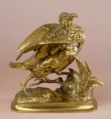
![]()
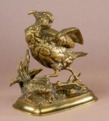
Paul-Édouard Delabrière [or
Delabrièrre] (French, 1829-1912), Shore Bird, bronze, c. 1870, 6 1/2 x 6 1/2 inches
(16.5 x 16.5 cm). A second point of view.
![]()
Alexander Phimister Proctor (American, 1862-1950),
Stalking Panther, 1891-92, revised mid-1890s
(this cast, c. 1914-17?), bronze,
9 1/2 x 37 1/2 x 6 1/4 inches (24.1 x 95.3 x 15.9 cm), Metropolitan
Museum of Art, NY.
Also see anthropomorphism, bestiary, equestrian art, equine art, gyotaku, singerie, and zoomorphic.
animatronics - See automaton, puppet, puppeteer, puppetry.
animism - The belief that everything, whether animate or inanimate, possesses a soul or spirit. It is a fundamental system of belief in the religions of numerous pre-industrial societies. In philosophy, the term can be applied to the view that in all things consciousness, or something mind-like exists. In developmental psychology, an animistic stage in the early thought and speech of the child has been described, notably by Jean Piaget (French, 1896-1980).
Also see anthropomorphism.
animus - See anima.
anneal - To heat and then cool metal or glass is to toughen or temper it — to remove internal stresses and make it easier to work when cool. In other words, this heating and slow cooling can strengthen, harden, and reduce brittleness. Mild steel and brass are allowed to cool slowly, while other metals, such as copper, may be quenched in water. Aluminum and glass are annealed by different processes.
Also see malleable.
annotation - Information added to an image, such as arrows, pointers, words, etc. Annotations to a digital image might be stored in layers separate from the image.
anodizing - An electrolytical process in which aluminum is coated with a protective or decorative oxide. This also greatly increases aluminum's ability to permanently hold paints and other coating materials.
anomaly - A deviation from the normal or expected form, order, or arrangement. Incorporating one or more anomalies in producing an artwork is among the possible means to achieving emphasis. The plural form is anomolies. The adjectival form is anomolous.
Also see contrast, counterpoint, Dada, fantastic, incongruity, and Surrealism.
antefix - An upright ornament along the edges or eaves of a tiled roof designed to conceal the joints between the rows of tiles, protecting exposed wooden parts of the architecture from the elements. In ancient times, antefixes were often placed on the roofs of Greek and Etruscan buildings. They were often decorated, and were typically made of terra cotta.
Examples:

Greece, Antefix decorated with a painted palmette,
from the Archaic temple at Aigira, 500 BCE,
terra cotta, Archaeological Museum
of Aigion, Greece. See palmette.
![]()
Etruscan, early 400s BCE,
Antefix, terra
cotta, 21 7/16 x 12 3/4 x 6 1/2 inches (54.6 x 32.5 x 16.5
cm), J. Paul Getty Museum, Malibu, CA. A silenos
and maenad dance in a Dionysian revel
on this Etruscan antefix.
Also see acroterion, Etruscan art, Greek art, and pediment.
anthropocentrism - The attitude that human beings are the central element in the universe.
Also see androcentrism, Afrocentrism, ethnic, ethnocentrism, Eurocentrism, iconocentric, and xenophobia.
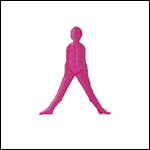 anthropomorphism - The representation
of inanimate objects,
animals, deities, or other phenomena, whether real or fictitious,
in human form, with human characteristics
and behaviors. People with pets often form close relationships with them, sometimes conversing with them. Anthropomorphising has appeared in the mythologies
of many cultures, as a literary device
in fables and allegories, and in
many animated films.
anthropomorphism - The representation
of inanimate objects,
animals, deities, or other phenomena, whether real or fictitious,
in human form, with human characteristics
and behaviors. People with pets often form close relationships with them, sometimes conversing with them. Anthropomorphising has appeared in the mythologies
of many cultures, as a literary device
in fables and allegories, and in
many animated films. Here is an anthropomorphic alphabet: human figures forming the uppercase or capital letters of the alphabet.
More examples:
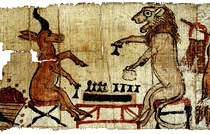
Possibly from Thebes, Egypt, Late New Kingdom, 20th dynasty, c. 1186-1069 BCE, Satirical Scene, papyrus, British Museum, London.
Greek, Attic, Black-Figure Eye Cup with Ships, Archaic, c. 530 BCE, terra cotta, Michael C. Carlos Museum, Emery U, Atlanta, GA. This cup appears to act as a mask when the cup is raised to drink — the eyes staring out, the handles resembling ears, and the foot of the vase appearing as a mouth. The eyes serve an apotropaic function, driving away evil. See black-figure, ex voto, talisman, vessel, and votive.
An engraving from C. Moore's 1797 translation of Lavater's Physiognomy, Vol 2, plate 122 , p. 100. This is a comparison between the heads of three men and the heads of three oxen.
Sir Edwin Landseer (English, 1802-1873),
The Traveled Monkey, 1827, oil
on panel, width
56 cm, Guildhall Library and Guildhall Art Gallery, London. The
narrative
is taken from the book Fables by English author John Gay.
See singerie.

Alexandre-Gabriel Decamps (French, 1803-1860),
The Experts, 1837, oil
on canvas, 18 1/4 x 25 1/4
inches (46.4 x 64.1 cm), Metropolitan Museum of Art, NY. See
singerie.
Louise Bourgeois (American, born France, 1911-), Eyes, 1982, marble, 74 3/4 x 54 x 45 3/4 inches (189.9 x 137.2 x 116.2 cm), Metropolitan Museum of Art, NY.
Laurie Simmons (American, 1949-), Walking Camera II (Jimmy the Camera), 1987, gelatin silver print, 83 1/8 x 47 5/16 inches (211.1 x 112.6 cm), Whitney Museum of American Art, NY. See photography.
Also see animalia, equine art, gyotaku, isms and -ism, puppet, singerie, talisman, and zoomorphic.
antialias or anti-alias - To smooth out the jagged edges of lines and shapes in a digital images that have been aliased — jagged instead of straight or smoothly curving. The jagged edges of an aliased image are also called jaggies. In many graphics software applications antialiasing can be turned on or off when using "pencil," "eraser," "paint bucket," and "magic wand" tools. Not all text or artwork looks better when it is antialiased. Small text or images sometimes look too blurry when they are antialiased. Antialiasing can substantially increase the file size of images, making their printing go more slowly, and Web pages load more slowly too.
Aliasing can be annoying when the resolution of a graphics file is too low. This can occur when an image is enlarged or copied from a source for which a lower resolution was more appropriate.
Examples:

The word "Antialiased" in an antialiased
Arial font at 18 point size
above an enlargement of that text.
This was produced with black, white, and 15 levels of grayscale.
The resolution of this and all images on the Web are at the standard
72 pixels per inch. In a print
medium, if this text were
produced at the same size, and antialiased at a higher level
of resolution, the lettering could be much smoother.

The word "Aliased" in an aliased
Arial font at 18 point size above an enlargement of that text.
Legibility is not greatly decreased, but the sharpness of the
letter's definition has.

The word "Aliased" in an aliased
Arial font at 9 point size above an enlargement of that text.
Legibility has greattly decreased in this example, especially
poor kerning that resulted
in a lack of letter space between
the first two letters. Take a fresh look at the three examples
with squinted eyes, or by moving several feet away from your
computer.
Also see graphic design.
anti-art - Art, either Dada or in its tradition, which rejects conventional theories and forms — techniques, materials, and means of display. Marcel Duchamp (French-American, 1887-1968) is credited with introducing the term c. 1914, and its spirit is summed up in his attempt to exhibit a urinal, Fountain of 1917, as well as in L.H.O.O.Q. — a reproduction of the Mona Lisa (La Joconde) on which he drew a mustache in 1919.
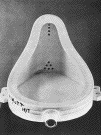
Marcel Duchamp, Fountain, 1917, readymade porcelain
urinal on its back. The urinal, purchased from "Mott Works"
company in New York and signed "R. Mutt," was submitted
to the jury-free 1917 Independents exhibition
but was suppressed by the hanging committee. This is a photograph
of either the second version of 1951 or the third of 1964.
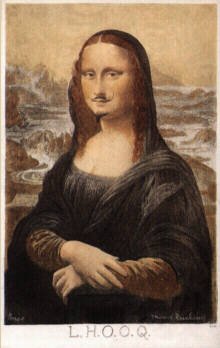
Marcel Duchamp, L.H.O.O.Q., 1919, rectified readymade, pencil
on a reproduction — a chromolithograph, 7 3/4 x 4
7/8 inches, private collection, Paris. As if the addition of
mustache and beard weren't enough of a poke at this most famous
of paintings, the letters Duchamp penciled — L.H.O.O.Q. — at
the bottom of his altered image are meaningless in themselves,
but when read aloud in French, make the sound of "Elle a
chaud au cul," meaning, "She has a hot ass." See
aerial perspective, landscape, Renaissance, sfumato,
text, and xenophobia.
Also see automatism, Fluxus, installation, readymade, ugly, and vandalism.
anti-authoritarian - Showing opposition to obeying authority, and favoring individual freedom.
anti-cerne - A white space in the form of a line between two areas of color in a picture; the opposite of a black line. Anti-cernes were often used by the fauve artists.
anti-intellectualism - Any point of view which opposes, fears, mistrusts, or shuns reason — logical, rational thought, intelligence, good judgment, sound sense — or intellectuals, or intellectual views.
antimony - A silvery white, brittle, yet soft metal, used in alloys to improve the working qualities of other metals, britannia, lead, and pewter, for example. Antimony sulfide was used as the cosmetic known as kohl in Egypt and other Middle Eastern countries. It is also used in making yellow glazes for ceramics, particularly majolica. Antimony suspended in lead was mined on the slopes of Mount Vesuvius from the Middle Ages, and was the source of an important orange-yellow pigment during the Renaissance called Naples yellow. This was paler than ocher but not as strong as the chrome yellows developed in the seventeenth and eighteenth centuries. Antimony oxides, not developed until the twentieth century, are also the source of white and vermilion pigments.
An example of a work utilizing antimony:

Richard Serra (American, 1939-), Prop, 1968, lead
antimony, 97 1/2 x 60 x 43 inches
(247.7 x 152.4 x 109.2 cm), Whitney Museum of American Art, NY.
See Minimalism.
antiquarianism - Originally, the admiration or study of the material culture of the past, especially of ancient societies, particularly those whose current descendants exhibit quite different customs, as in Greece. To some, the term now has a connotation of commercialism and commodity exchange for profit, rather than for scholarly goals.
Also see commodification, Egyptian art, Etruscan art, Greek art, iconoduly, neoclassicism, and Roman art.
antique - Of ancient times, or an object made in a bygone era. Especially of the ages before the fall of the Western Roman Empire in CE 476. Also, ancient furniture and other artifacts. And, plaster casts of classical sculptures used in drawing classes to study form. The word antique is sometimes used very loosely to refer to any object in order to impart a sense of its being old. Sellers of old stuff — antiques — often use this means of emphasizing their wares' aged qualities. For the purposes of U.S. customs, an object made at least one hundred years prior to the date of its entry into the U.S.
Also see antiquarianism, antiquing, and antiquity, Buddhist art, Egyptian art, Etruscan art, Greek art, Hindu art, Islamic art, Roman art, and Stone Age art. Also see allegory and patina.
antiquing - Artificially creating an appearance of age to the surface of an object. This has most often been done to furniture, walls, and decorations, but has been done to create new and to simulate old fine art as well. Techniques for antiquing include abrading and otherwise distressing surfaces to simulate wear, and glazing, often with burnt or raw umber, over other colors to simulate the dirtying and discoloring of age. Sometimes refers to the act of shopping for antiques.
Also see allegory, antiquarianism, antique, antiquity, art conservation, art restoration, clean up, distort, forgery, new, patina, and time.
antiquity - The quality of being very old, especially of the ages before the fall of the Western Roman Empire in CE 476. Also, the remains of ancient times, usually referred to in the plural form, as antiquities.
Also see antiquarianism, antique, antiquing, Buddhist art, Egyptian art, Etruscan art, Greek art, heritage, Hindu art, Islamic art, Roman art, Stone Age art, UNESCO Convention on the Means of Prohibiting and Preventing the Illicit Import, Export and Transfer of Ownership of Cultural Property, and UNIDROIT Convention on Stolen or Illegally Exported Cultural Objects.
antithesis - A single figure with directly opposing ideas. Also, the second and contrasting part of such a juxtaposition.
![]()

![]() anvil - A
heavy, steel-faced iron block on which to
form metal
by hammering or forging — wrought metal, or metal that
is red-hot and malleable, then
hammered into shape. Most anvils
have both flat and curving
surfaces.
anvil - A
heavy, steel-faced iron block on which to
form metal
by hammering or forging — wrought metal, or metal that
is red-hot and malleable, then
hammered into shape. Most anvils
have both flat and curving
surfaces.
Also see horn.
anxiety - Fear, whether justified or not. Angst. Unjustified, anxiety can be produced by pathologies known as phobias. Examples of phobias: gymnophobia, iconophobia, and xenophobia.
Examples of works in which anxiety is important:
![]()

![]()
Edvard Munch (Norwegian, 1863-1944), Anxiety, 1894, oil on canvas, 94 x 73 cm.

Edvard Munch, Angst, 1896, woodcut, composition: 18 1/16 x 14 7/8 inches (45.9 x 37.8 cm); sheet: 19 5/16 x 15 3/4 inches (49 x 40 cm); publisher: the artist, Paris; printer: Auguste Clot, Paris; edition: approximately 50, 26 in black; Museum of Modern Art, NY. See Expressionism.

Max Beckmann (German, 1884-1950), Die Nacht (Night) from Die Hölle (Hell), 1919, one from a portfolio of eleven lithographs, composition: 21 15/16 x 27 11/16 inches (55.8 x 70.4 cm); Museum of Modern Art, NY. See Die Brücke.
Alberto Giacometti (Swiss, 1901-1966), The Nose, 1947, plaster on metal, suspended by synthetic string within a metal structure, 81.5 x 66 x 36.7 cm, Centre Georges Pompidou, Paris.
Quotes:
Also see angst, ethnocentrism, existentialism, and pain.
https://inform.quest/_art